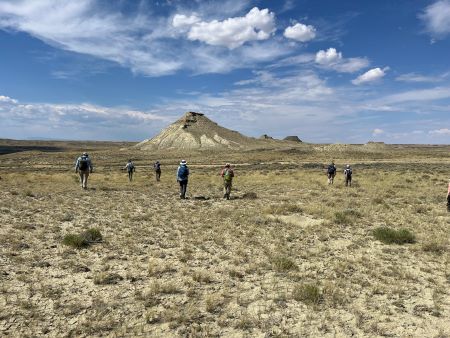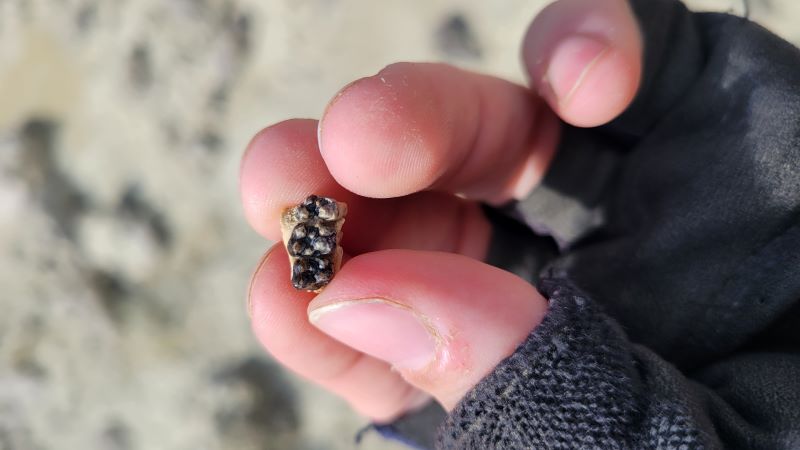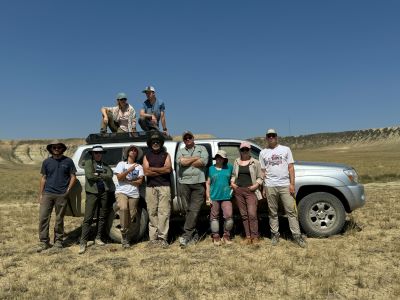#KUFieldWorks: Studying past climate change events through fossils
Editor’s note: Fieldwork provides invaluable insights about real-world environments and processes, expanding and reinforcing what researchers learn in classrooms, labs and collections. KU faculty, staff and students across a spectrum of disciplines take their inquiry directly to rivers, prairies, dig sites, glaciers, islands, archives and more. Through the #KUFieldWorks series, we'll join them on their adventures.
Q&A with Parker Rhinehart, doctoral candidate in the department of ecology & evolutionary biology
Studying the past might offer hints as to what lies in our future. Parker Rhinehart and his colleagues look to the fossil record to analyze the Paleocene-Eocene Thermal Maximum, a period of intense climate change that dramatically altered the evolution of life on Earth. Studying this may help predict how the ecosystem will adapt to climate change in the present and near future.

What methods, approaches, experiments, etc. are you using?
Fieldwork for the vertebrate paleontology lab at KU normally consists of surface collecting in the badlands of Wyoming. Fossils are exposed through the processes of weathering and erosion, where wind and rain break down the exposed surface to reveal what is underneath. After a year or two of erosion, we visit localities where we know mammal fossils occur and search the surface for small mammal teeth and other bones that have been recently uncovered by these processes. Our lab specializes in early Cenozoic mammals, and our fieldwork localities date to between 50-60 million years old. Most of the mammals that lived during this time are small, and the largest is only about the size of a modern sheep.
Why does your study matter to your field or for society?
Collecting fossils is what guides paleontology forward. Many of the new methods in paleontological research involve analyses that utilize large data sets in interesting ways. However, to obtain that data, field crews must collect more fossils to fill in the gaps in our knowledge, which is a critical aspect of advancing our science.
The time period we study is one of the largest climate change events in history, the Paleocene-Eocene Thermal Maximum (PETM). The PETM is a climate event where the global temperature rapidly rose by 5-8 degrees Celsius, raising sea level and drastically changing the paleoclimate. An event of that severity would have had an incredibly strong impact on how species evolve and what species go extinct. Studying how the PETM impacted fossil species and ecosystems allows us to predict how modern climate change could affect modern ecosystems as global warming continues.

What do you enjoy most about being in the field?
The views in Wyoming are spectacular, and sharing the beautiful landscape with my friends and colleagues is the cherry on top. And, of course, I have to say finding the fossils themselves is amazing, too. When you find a fossil, you are the first person who has ever touched that part of history. Every new find gives you a feeling of discovery. Traveling to fieldwork always provides interesting challenges and cool new people to meet, whether that is in Wyoming or in our lab’s other fieldwork abroad in Turkey. Fieldwork is also one of the best ways to learn how to identify fossil species as you watch the field crew identify fossils and explain their reasoning in real time. Identifying the fossils we find often leads to interesting discussions about current research focused on that species.
What are some memorable (funny, scary, surprising, etc.) moments from the field?
One memory from the field that really stands out was a day that we went to find one of our previously known fossil localities. We drove down a private road thinking it was a county road. We passed through and parked the cars before walking a mile or so out to the locality. We spent the morning searching for fossils before coming back to the cars for lunch. When we arrived back at the cars, notes had been left on the windshields of all four cars declaring that we had trespassed and if we drove through again, we would be “detained” and the sheriff would be called. Luckily, shortly after we got back to the cars, a power company employee drove by and offered to show us the back way to the interstate, avoiding private roads.

When is fieldwork frustrating, challenging or overwhelming?
Due to the nature of fossil preservation, not every site can be flush with fossils. Some days, our searching is less fruitful and can be frustrating, as everyone bakes in the hot sun with no reward. Camping in the Wyoming badlands also presents its own challenges. Our campsites often have no source of water, and arranging meals and staying clean for a week or two in the desert can be tricky.
How does fieldwork complement the work you do elsewhere?
Collecting fossils is the primary way to gather more data. Each place you collect fossils raises new questions about the life that existed in that prehistoric environment. A secondary joy of fieldwork is conducting research utilizing the fossils you helped find. When we bring the fossils back to the lab, we get to describe a new species, perform new analyses, and share our findings with the public through museum outreach. Fossils collected during these field seasons often become the center point of the research that our lab takes to conferences to present and get important feedback from other experts in the field.
First photo: University of Kansas researchers conduct fieldwork in prairies, rivers, streams and mountains. The #KUFieldWorks series follows researchers on their fieldwork adventures.
Second photo: The Wyoming field crew walking toward a potential fossil locality. Photo credit: Kathleen Rust
Third photo: Three-tooth upper jaw of a small mammal from the Eocene of Wyoming. Photo credit: Kristen Miller
Fourth photo: A group picture of the entire field crew in front of one of their field vehicles. Photo credit: Robert Anemone